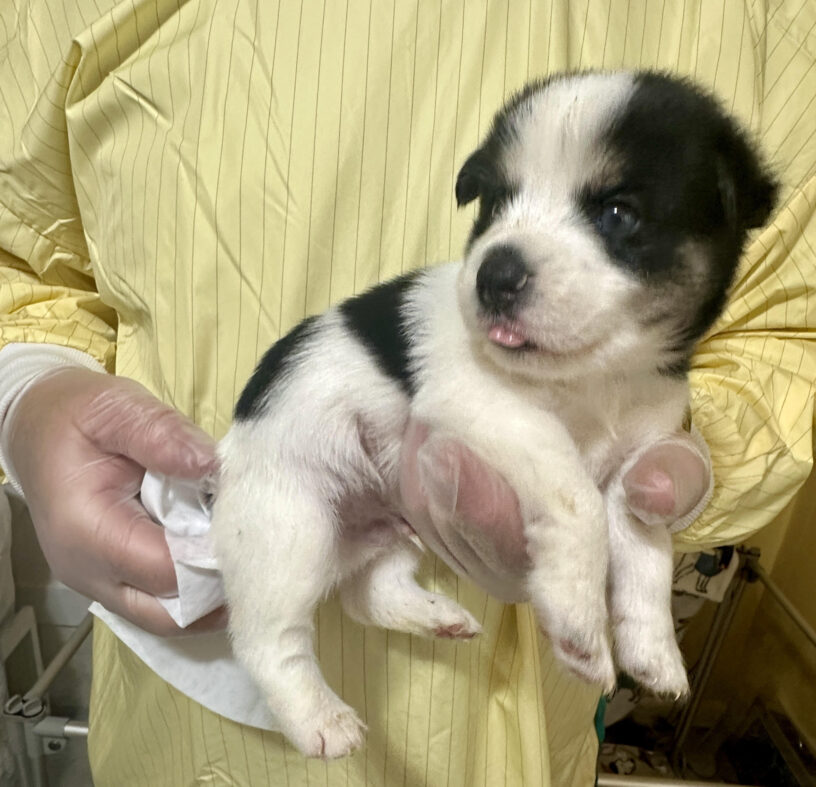Caring for orphaned newborn puppies means stepping in for their mother in every possible way—feeding, keeping them warm, helping them sleep, and something many people don’t realize: helping them go to the bathroom.
For the first few weeks of life, puppies can’t pee or poop on their own. It’s not automatic. And if you’re not helping them eliminate after every meal, you’re risking far more than a messy crate—you’re risking their lives.
Why Newborn Puppies Can’t Eliminate on Their Own
Puppies are born with immature nervous and muscular systems. For the first 2–3 weeks, they have no voluntary control over their bladder or bowels. In a natural setting, the mother dog licks their genital and anal areas before and after each feeding to stimulate them to urinate and defecate.
Without that physical stimulation, waste builds up inside the body. And in a puppy that’s already fragile, that’s all it takes to cause bloating, pain, infection—or death.
When and How to Stimulate Bottle Babies
Timing is just as important as technique. Stimulation must happen both before and after every feeding—no exceptions.
Step 1: Stimulate Before Feeding
Stimulating before feeding helps empty the bladder or bowels so the puppy is more comfortable and less likely to eliminate during the feeding itself. This reduces stress and supports healthy digestion.
Step 2: Stimulate After Feeding
Once the meal is finished, the body begins to process food. This is when the digestive system kicks in—and it’s the most likely time for the puppy to need to eliminate. Always stimulate again after feeding to give them a chance to relieve themselves.
How to Do It Correctly
Use a soft tissue, cotton pad, or fragrance-free baby wipe. Gently dab the genital and anal areas using a light, circular or back-and-forth patting motion.
-
Use a fresh wipe for each puppy to avoid cross-contamination.
-
Always support the puppy’s body, and keep them warm during the process.
-
Keep stimulation gentle—you’re mimicking a mother’s tongue, not scrubbing a floor.
Most puppies will urinate within 15–30 seconds. Bowel movements may take longer and typically happen only a few times per day, depending on age and formula.
What to Look For: Healthy Output vs Warning Signs
Elimination isn’t just about volume—it’s a diagnostic tool. Every stool and urine output offers a clue about the puppy’s internal health.
Urine
-
Normal: Pale yellow, clear
-
Too dark: May indicate dehydration
-
No urine: May indicate a blockage or serious medical issue—seek veterinary support immediately
Stool
-
Normal: Soft and yellowish-brown
-
Hard, dry, or white: May indicate over-concentration or formula issues
-
Green, bloody, or mucus-filled: Could indicate infection, parasites, or GI disease—document and alert your coordinator or vet
When to Stop Stimulating
Most puppies begin to eliminate independently between 3 and 4 weeks of age. You’ll notice signs such as squatting during or after feedings, or spontaneous peeing during play. At this point, you can begin tapering down your stimulation efforts—but continue monitoring for complete elimination.
If a puppy over 3 weeks old still shows no sign of urinating or defecating on their own, continue stimulation and consult with your doctor.
Why Missed Stimulation Is Dangerous
It might seem harmless to skip a session—especially during overnight feedings—but for a puppy that weighs less than a pound, missed elimination can lead to:
-
Painful bloating
-
Urine scalding (a chemical burn from prolonged contact with acidic urine)
-
Constipation or impaction
-
Bladder rupture
-
Sepsis from untreated infections
Puppies have no way to tell you something’s wrong until it’s too late. Consistent stimulation is how we prevent silent suffering.
Urine Scald: What It Is and How to Prevent It
One of the most common and preventable conditions in bottle babies is urine scald—a painful rash caused by constant skin contact with urine.
Signs of Urine Scald
-
Red, inflamed skin around the lower belly, tail base, or thighs
-
Raw or weepy sores
-
Puppy cries or resists touch during stimulation
How to Prevent It
-
Stimulate before and after feeding
-
Gently clean and pat dry after each elimination
-
Change bedding frequently—at least every 2-4 hours, more often if soiled
-
Keep puppies on soft, absorbent surfaces like fleece or puppy pads
Final Thoughts
In the grand picture of puppy care, stimulation may seem like a minor task. But for orphaned neonates, it’s every bit as important as feeding and warmth. Without it, a puppy cannot survive.
These puppies can’t do it alone. But with your hands, your heart, and the right technique, they don’t have to.

